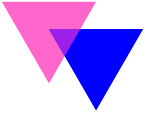Bisexual flag
The flag of the bisexuals serves as a worldwide identification symbol and to represent the pride of bisexuals .
history
The flag was created in 1998 by Michael Page with the intention of giving bisexuals a symbol with recognition value . The existing symbols of the lesbian and gay movement , such as the rainbow flag or the lambda symbol, were considered symbols of this movement and the bisexuals could not fully identify with them. Page's goal was to increase the visibility of bisexual people in both society and the LGBT community. The first bisexual flag was unveiled on December 5th, 1998 at the celebration of the first anniversary of the BiCafe.
symbolism
The colors are based on the following color symbols :
- Blue stands for heterosexuality
- Pink stands for homosexuality
- Purple, as a result of blending blue and pink, represents bisexuality. Often, however, it also includes attraction to people with a non-binary gender identity who do not identify with any gender.
Design and colors
Page took colors from a pre-existing symbol of bisexuality and gave it its own twist, saying, "In creating the bi-flag, I chose the colors and overlapping patterns of the 'Biangles' symbol."
Biangles, or 'Bisexual Triangles', are another symbol of the bisexual community with unknown origins. The crescent moon symbol is another distinctive sign of bisexuals which intentionally avoids the symbolism of the pink triangle.
Page describes the meaning of the pink, lavender and blue flag (ratio 2: 1: 2) as follows: "The pink color represents sexual attraction to the same sex (gay and lesbian). The blue color represents sexual attraction to the opposite sex ( Heterosexual) and the purple color that results from the overlap stands for the sexual attraction to both sexes (Bi).
He explains the deeper meanings of the flag with the following statement: "The key to understanding the symbolism of the bisexual flag lies in the knowledge that the purple color pixels pass unnoticed into both the pink and blue colors, as well as in the real world ', in which bisexual people fit in unnoticed in gay and lesbian as well as in the heterosexual community. "
The flag is used in different aspect ratios. 2: 3 and 3: 5 are often used, as is the case with many other flags; on the (now closed) website biflag.com, 3: 4 was given as the "exact ... proportions" of the "original Bi-Pride flag".
Colours
The stripe colors and widths are pink (40%), purple (20%) and blue (40%) from top to bottom. The exact colors specified by the designer are: PMS 226, 258 and 286; their approximate HTML values are # D60270, # 9B4F96, # 0038A8. Their approximate RGB values are (214,2,112), (155,79,150) and (0,56,168), respectively. The colors are not patented, trademarked or labeled as a service.
| colour | PMS | RGB | Hex |
|---|---|---|---|
| pink | 226 | 214, 2, 112 | # D60270 |
| purple | 256 | 115, 79, 150 | # 734F96 |
| blue | 286 | 0, 56, 168 | # 0038A8 |
Controversy over licensing
In 1998, Page decided that the Bi-Flag was "for free public and commercial use" and that it was "not patented, trademarked, or labeled as a service". In April 2020, BiNet USA claimed that it was the sole copyright owner of the flag and flag colors, saying that organizations and individuals who wanted to use the flag for commercial purposes would need to obtain a license from the organization. BiNet's claim and the resulting controversy were covered by Out (magazine) and LGBTQ Nation , who expressed doubts about BiNet's claim, stating that the flag was not eligible for copyright.
On April 29, 2020, BiNetUSA posted a tweet claiming the Wikipedia page for the flag was inaccurate.
Alternative representation
There is also an alternative representation of the flag as a color gradient instead of the separate color bars. This is supposed to represent the continuum and the smooth transition of sexual orientations.
See also



